Foreign Insulators
by Marilyn Albers
Reprinted from "Crown Jewels of the Wire", June 1998, page 19
MORE NEW FINDS ON THE FOREIGN FRONT
TWO CD 517'S WITH NEW FACES
Collectors of foreign glass are pretty familiar with CD 517. It is a fairly
common style and has been rather easy to find at insulator shows. Glass colors
include off clear, light straw, sage green, and light blue. All the examples
we've seen originated in Italy and have slightly different embossings. Shown
below are two new embossing variations.
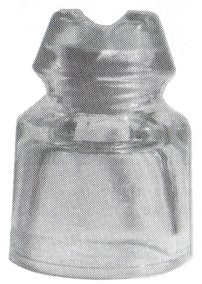
"CD 517  " "
This particular 517 is a pretty light blue. The date (19)78 appears on the
front skirt along with a mold number and the  trademark. The embossing on the
rear skirt is B-100/UNEL-38112. Eric Johnson of Stuart, Florida, who has done
some research on Italian insulators while on trips to Italy, attributes this
trademark. The embossing on the
rear skirt is B-100/UNEL-38112. Eric Johnson of Stuart, Florida, who has done
some research on Italian insulators while on trips to Italy, attributes this  to a company called BORMA, which he believes may be connected in some way to the
MIVA factory. On the other hand, it could be a completely independent
manufacturer - time will tell. The only other CD's we have seen with this
trademark are a couple of cemented three piece insulators - CD 377.2 and CD 383
- so at this time it's an uncommon embossing to collectors on this side of the ocean.
I understand that some soft drink
bottles from Italy also bear the
to a company called BORMA, which he believes may be connected in some way to the
MIVA factory. On the other hand, it could be a completely independent
manufacturer - time will tell. The only other CD's we have seen with this
trademark are a couple of cemented three piece insulators - CD 377.2 and CD 383
- so at this time it's an uncommon embossing to collectors on this side of the ocean.
I understand that some soft drink
bottles from Italy also bear the  trademark. trademark.
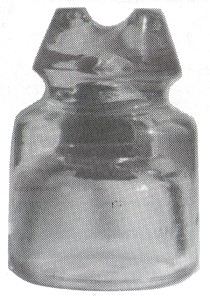
"CD 517 FLAMREX"
The front skirt of this insulator
is embossed B-100/ FLAMREX 80( date) with a mold number 10 on the rear skirt.
The glass color is light straw. We wonder if the word FLAMREX indicates that the
insulator is made of treated glass like PYREX glass, but because that name was
already under copyright, the manufacturer had to call it something else. There
are now three known CD's with the FLAMREX trademark - CD 444, CD 517, and CD
1055.2, and they all appear to be of recent production. Hopefully, when Eric
goes back to Italy he will be able to find out the name of the company that
makes them. In the meantime, we continue to admire the glass!
THIS ONE IS TO DIE FOR!
This has got to be the most beautiful insulator I've ever seen! The rich
emerald green color of the glass is breathtaking and judging from its bright
shiny appearance, I would say it's probably a relatively new product. FIDENZA is
embossed low on the front skirt with No 1 D on the opposite side. This is a new
embossing variation for CD 539, the others being MIVA and PYREX.
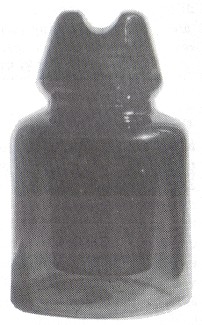
"CD 539 FIDENZA"
Fidenza Glassworks is a large organization located in the city of Fidenza,
northern Italy, with headquarters in Milan. We know of fifteen CD's made by this
company and since they are still producing insulators, there must be many other
styles that we're unaware of. Fidenza also produces several other glass
products, such as jars, lighting fixtures, covers for headlights, building
blocks and other special glasses.
ITALIAN SPOOKS COME OUT OF THE CLOSET
Several years ago I purchased a CD 655.5 in light blue aqua from a collector
who was gradually easing his way out of the hobby. It was so unusual and so
pretty I just had to have it! The insulator was embossed MIVA on the front
skirt and B T 2 V on the back. I had no idea what MIVA stood for but I was told
that the insulator came from Italy and had been used as a fuse insulator. After
staring at those two "eyes" in the crown, I began calling it the
"spook" (I'm guilty, I started it and it stuck!). Since that time
other glass spooks in various sizes have been found in clear, green, and aqua.
Some came from Spain, several from France and a few from other countries that
imported French insulators, but no others from Italy. Did I have the only
Italian spook? Where were the rest of them? Who dropped the ball?
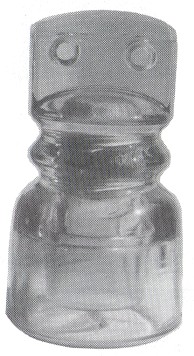
"CD 655.5 MIVA"
Then just a short time ago, a small number of CD 655.5's were found in an
off clear. One of these is shown in the photo above. The embossing is exactly the
same as on my light blue aqua insulator, which I suspect may be older than these
recent finds. It's quite a feeling to see the two contrasting colors next to
each other on the shelf! We now know that MIVA stands for Manifattura lsolatori
Vetro Acqui, or (the) Manufacture (of) Glass Insulators
(at) Acqui Hot Springs.
I recently purchased this interesting spook in dark
yellow green. It's embossed MIVA on the front skirt and B T 3 V on the reverse
side. Notice that this embossing is almost identical to that on the CD 655.5 MIVA above, except for the number 3 on the back which indicates the size of the
insulator. This can be confusing - 3 is smaller than 2!
N.R. Woodward has
classified the MIVA B T 3 V as a CD 653.1 variation, though it's a bit wider
and taller and has more of a slope to the skirt than the FOLEMBRAY No 294 to
which this number was originally given.
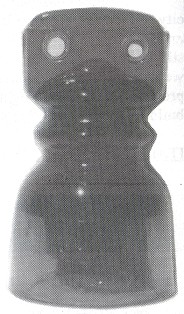
"CD 653.1 MIVA variation"
WHAT A PAIR!
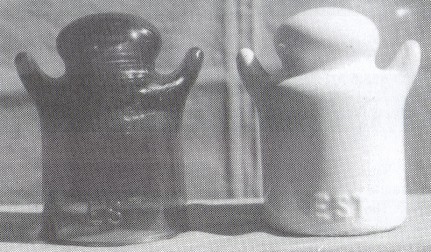
"CD 641.2 with its porcelain twin"
Pictured on the previous page we have a couple of French gingerbread
"Mommas", one in olive green glass and the other in white porcelain.
The glass Momma is a CD 641.2, and most collectors are familiar with this style,
but it was really a surprise to see the porcelain twin at the London, Ohio Show
in November of 1997. It caused quite a stir among collectors in attendance! A
shadow profile of this piece has been made, complete with all the measurements,
and the insulator is now waiting for a final inked drawing and a U-number.
As
you can see, both insulators carry the EST embossing, which is the French word
for "East". This indicates that the insulators were used along the
East Branch of the French National Railway Line. The CD 641.2 also has the
embossing FOLEMBRAY/DÉPOSÉ on the front skirt, but EST is the only marking on
the porcelain piece.
JACK SPRAT
These two T-bars remind me of the nursery rhyme called "Jack
Sprat". Remember how it goes - "Jack Sprat could eat no fat and his wife could eat no lean". Guess which one is Jack's wife!
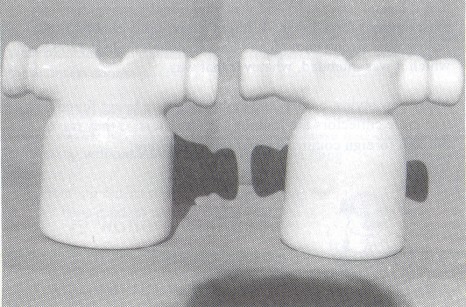
"Ginori T-bars"
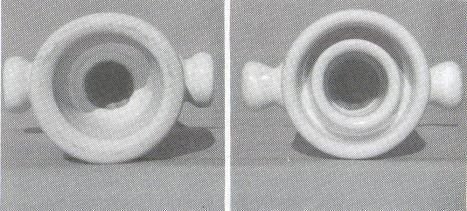
"Interior view of T-bars"
Both insulators were manufactured by the old and well established company of
Richard Ginori in Milan, Italy. The example to the right in the photo looks
normal enough, but the one on the left is a real eye catcher because of its
thick profile and short stubby arms. Another interesting thing about it is that
it has no inner skirt and was intentionally made that way most unusual for a
T-bar. Without a doubt this chubby little fellow was strong enough and heavy
enough to do the job for which it was intended, whatever that was.
Many new styles, colors, and embossings are being found now that more
collectors are looking for insulators as they travel through foreign countries -
and this is exciting!
| 